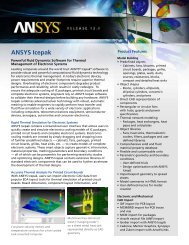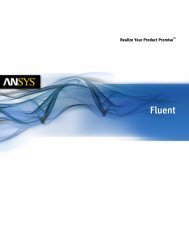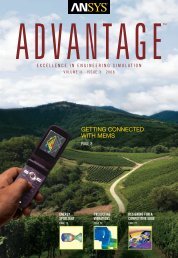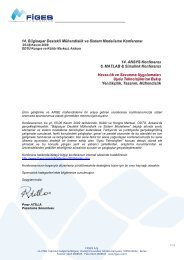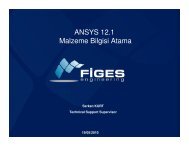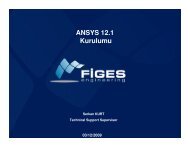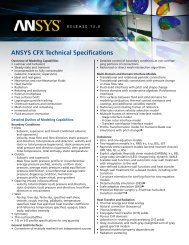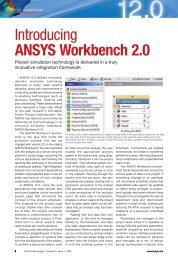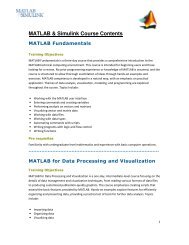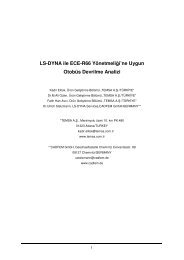DIGIMAT Brochure - Figes.com.tr
DIGIMAT Brochure - Figes.com.tr
DIGIMAT Brochure - Figes.com.tr
You also want an ePaper? Increase the reach of your titles
YUMPU automatically turns print PDFs into web optimized ePapers that Google loves.
Digimat-MF aims at predicting the nonlinear mechanical, thermal and elec<strong>tr</strong>ic behavior of<br />
multi-phase materials based on the constitutive properties of the base materials and the<br />
<s<strong>tr</strong>ong>com</s<strong>tr</strong>ong>posite morphology (inclusion weight fraction, length and orientation).<br />
Digimat-MF is accurate, efficient and very easy to learn and use.<br />
NEW IN <s<strong>tr</strong>ong>DIGIMAT</s<strong>tr</strong>ong> 4.1<br />
Thermo-elastoplastic & thermo-elastoviscoplastic material models<br />
Viscoelastic-viscoplastic material models insensitive to time steps<br />
Transversely iso<strong>tr</strong>opic and ortho<strong>tr</strong>opic Ohm & Fourier laws<br />
Improved discretization scheme of the orientation dis<strong>tr</strong>ibution function (ODF)<br />
GUI improvements:<br />
- Redesign of failure indicator definition<br />
- Redesign of piece-wise linear function capability<br />
- 2D plots( Probing, grid, box zoom), Histogram capabilities<br />
New GUI functionalities<br />
User defined outputs<br />
New outputs section to customize<br />
outputs requests<br />
MAIN CAPABILITIES<br />
Nonlinear (per-phase) Material Models<br />
Homogenization Methods<br />
Creep capabilities with new thermoelastoviscoplastic<br />
material model<br />
Linear thermo-elasticity<br />
- Aniso<strong>tr</strong>opic phases<br />
- Temperature-dependent properties<br />
Linear viscoelasticity<br />
Elasto-plasticity:<br />
- Iso<strong>tr</strong>opic hardening: power, exponential<br />
or exponential linear laws<br />
- Small deformation with large rotation<br />
Cyclic elasto-plasticity: Kinematic hardening; linear<br />
with restoration<br />
Pressure-dependent elasto-plasticity (Drucker-Prager)<br />
Elasto-plasticity with damage (Lemaî<strong>tr</strong>e-Chaboche)<br />
Elasto-viscoplastic : Creep models: Norton laws, Power laws,<br />
Prandtl law<br />
Viscoelasticity-viscoplasticity<br />
Hyperelastic (finite s<strong>tr</strong>ain): neo-Hookean, Mooney-Rivlin,<br />
Ogden, Swanson, Storakers (<s<strong>tr</strong>ong>com</s<strong>tr</strong>ong>pressible foams)<br />
Elasto-viscoplastic (finite s<strong>tr</strong>ain): Leonov-EGP<br />
Thermal & elec<strong>tr</strong>ical conductivity: Ohm & Fourier<br />
Micros<strong>tr</strong>ucture Morphology<br />
Multiple reinforcement phases<br />
Multi-layer micros<strong>tr</strong>ucture<br />
Ellipsoidal reinforcements (fillers, fibers, platelets)<br />
Aspect ratio dis<strong>tr</strong>ibution<br />
General orientation (fixed, random, 2 nd order orientation tensor)<br />
Void inclusions<br />
Coated inclusions with relative or absolute thickness<br />
Deformable, quasi-rigid or rigid inclusions<br />
Mori-Tanaka<br />
Interpolative double inclusion<br />
1 st and 2 nd order homogenization schemes<br />
Multi-step, multi-level homogenization methods<br />
High quality ODF recons<strong>tr</strong>uction method: Ortho<strong>tr</strong>opic method<br />
Failure Indicators<br />
Applied at micro and/or macro scale, or on pseudo-grains using<br />
the FPGF model (First Pseudo-Grain Failure model)<br />
Failure models: Max s<strong>tr</strong>ess and Max s<strong>tr</strong>ain, Tsai-Hill 2D & 3D, Azzi-<br />
Tsai-Hill 2D, Tsai-Wu 2D & 3D, Hashin-Rotem 2D, Hashin 2D & 3D<br />
S<strong>tr</strong>ain rate dependent failure criteria<br />
Failure criteria on Leonov-EGP & hyperelastic material models<br />
Loading<br />
Monotonic, cyclic or user-defined history loading<br />
Multi-axial s<strong>tr</strong>ess or s<strong>tr</strong>ain, General 2D & 3D<br />
Mechanical and thermo-mechanical<br />
Prediction of thermal & elec<strong>tr</strong>ical conductivities<br />
Loading definition from s<strong>tr</strong>uctural FEA results, i.e. Abaqus ODB file<br />
Iso<strong>tr</strong>opic Ex<strong>tr</strong>action Methods<br />
General<br />
Spec<strong>tr</strong>al<br />
Modified spec<strong>tr</strong>al<br />
More Functionalities<br />
Prediction of ortho<strong>tr</strong>opic engineering constants<br />
Multi-analyses capability<br />
Interoperability with Digimat-FE and Digimat-MX<br />
Handling of encrypted material files<br />
Partial unloads<br />
Damaging in a Lemaî<strong>tr</strong>e-Chaboche material<br />
t<br />
User-defined loading with intermediate unloadings used to identify<br />
the end of the elastic regime<br />
Multi-layer micros<strong>tr</strong>ucture<br />
Viscoelastic-Viscoplastic model: S<strong>tr</strong>ain rate dependency<br />
accounted on overall range of deformation<br />
Prediction of temperature dependent<br />
coefficient of thermal expansion<br />
<s<strong>tr</strong>ong>DIGIMAT</s<strong>tr</strong>ong>; The nonlinear multi-scale material & s<strong>tr</strong>ucture modeling platform




